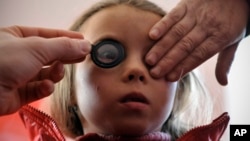Amblyopia is a Greek word that means "blunt vision." It's often called "lazy eye," and is one of the most common vision problems in children.
Amblyopia is usually treatable, but if left untreated it can affect a child's reading and fine motor skills, which can negatively impact academic success and self-esteem. Untreated amblyopia can also lead to blindness.
With amblyopia, one eye sends stronger electrical signals to the brain than the other one does. If untreated, the pathways the weaker eye uses to send signals can weaken further or fail to develop.
Doctors commonly treat the condition with a patch over the strong eye to force the weak eye to take over and develop the pathways to the brain. But this treatment may not make the eyes work together. A child may end up using one eye for distance vision and the other for seeing close up.
Researchers at the Retina Foundation of the Southwest in Dallas, Texas, wanted to see if they could improve on the standard treatment given to children with this condition.
"Amblyopia not only has deficits in vision, but it causes deficits in 3-D-depth perception, reading and fine motor skills," said Dr. Krista Kelly, who led the study.
These deficits can last through adulthood. Without three-dimensional vision, a person's ability to drive a car, read textbooks and generally see the world can remain impaired.
Game on iPad
Researchers gave children with amblyopia an iPad and a pair of glasses, and had them play a specially developed video game. The children ranged in age from 4 to 10 years old. The researchers also supplied glasses that changed the way the children saw things. The kids had to work the weaker eye harder in order to play the game, which also forced the children to work both eyes together.
Children with amblyopia in another group were given only eye patches. After two weeks, Kelly said, both groups were evaluated.
Kelly said the improvement between the two groups was pronounced. "We found that at the two-week visit, children who had the iPad game improved much more than children who patched."
The children who played the iPad games had improved so much that the researchers gave the iPad and the game to both groups of children. After two more weeks, with both children playing the game, those who had started out in the eye patch group had caught up to the other group.
Kelly now wants to add new games, or even videos, and have the children play the games or watch the videos for more than four weeks.
The study appeared in JAMA Opthalmology.




